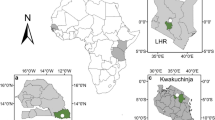Abstract
The durations of logging operations may be regarded as critical periods in which primates will be required to make rapid adjustments in behavioral patterns. Primates are extremely difficult to observe during logging operations, but their behavioral response may be interpreted from analysis of calling patterns. In Hylobates lar,increased calling frequencies of groups may be indicative of intruder pressure, as may reduced calling frequencies of animals which are avoiding confrontation with conspecifics or avoiding detection by loggers. In Presbytis melalophosthe function of calling is to mediate intergroup avoidance, such that differential calling frequencies would not be expected. Where reduction in calling occurs it is probably directed toward concealment from loggers. Groups do not emigrate from active logging areas and movement outside of established territories occurs only to a very limited extent.
Similar content being viewed by others
References
Chivers, D. J. (1974). The siamang in Malaya: A field-study of a primate in tropical rain forest.Conlrib. Primatol. 4: 1–335.
Chivers, D. J., and MacKinnon, J. R. (1977). On the behaviour of siamang after playback of their calls.Primates 19: 943–948.
Curtin, S. H. (1980). Dusky and banded leaf monkeys. In Chivers, D.J. (ed.),Malayan Forest Primates, Plenum Press, New York, pp. 107–145.
Ellefson, J. O. (1974). A natural history of gibbons in the Malay Peninsula. In Rumbaugh, D.M. (ed.),Gibbon and Siamang, Vol. 3, Karger, Basel, pp. 1–36.
Gittins, S. P., and Raemaekers, J. J. (1980). Siamang, lar and agile gibbons. In Chivers, D.J. (ed.),Malayan Forest Primates, Plenum Press, New York, pp. 63–105.
Groves, C. P. (1973). Notes on the ecology and behaviour of the Angola colobus (Colobus angolensis P. L. Sclater I860) in N.E. Tanzania.Folia Primatol. 20: 12–26.
Johns, A. D. (1983).Ecological Effects of Selective Logging in a West Malaysian Rain-Forest, Ph.D. dissertation, University of Cambridge, Cambridge, U.K.
Johns, A. D. (1985a). Effects of selective logging on the behavioral ecology of West Malaysian primates.Ecology (in press).
Johns, A. D. (1985b). Differential detectability of primates between primary and selectively logged habitats and implications for population surveys.Am. J. Primatol. 8: 31–35.
Johns, A. D. (1985c). Selective logging and wildlife conservation in tropical rainforest: problems and recommendations.Biol. Conservat. 31:355–375.
Kavanagh, M. (1980). Invasion of the forest by an African savannah monkey: behavioural adaptations.Behaviour 73: 238–260.
MacKinnon, J. R. (1971). The orang-utan in Sabah today.Oryx 11: 141–191.
Martin, C., and Asibey, E. O. A. (1979). Effect of timber exploitation on primate population and distribution in the Bia rain forest area of Ghana. Paper presented to Vllth Congress I.P.S., Bangalore, India.
Mitani, J. C. (1985). Gibbon song duets and intergroup spacing.Behaviour (in press).
Petter, J. J., and Peyriéras, A. (1974). A study of population density and home ranges ofIndri indri in Madagascar. In Martin, R.D., Doyle, G.A., and Walker, A.C. (ed.),Prosimian Biology, Duckworth, London, pp. 39–48.
Rijksen, H. D. (1978).A Field Study of Sumatran orang-utans (Pongo pygmaeus abelii,Lesson 1827): Ecology, Behaviour and Conservation, H. Veenman and Zonen, B. V. Wageningen.
Robinson, J. G. (1981). Vocal regulation of inter- and intragroup spacing during boundary encounters in the titi monkey,Callicebus moloch. Primates 22: 161–172.
Walek, M. L. (1978). Vocalizations of the black-and-white colobus monkey (Colobus polykomos Zimmerman 1780).Am. J. Phys. Anthrop. 49: 227–240.
Waser, P. (1975). Experimental playbacks show vocal meditation of avoidance in a forest monkey.Nature (London) 225: 56–58.
Watanabe, K. (1981). Variations in group composition and population density of the two sympatric Mentawaian leaf-monkeys.Primates 22: 145–160.
Whitmore, T. C. (1984).Tropical Rain Forests of the Far East, 2nd ed., Clarendon Press, Oxford.
Whitten, A. J. (1982). The ecology of singing in Kloss gibbons (Hylobates klossii) on Siberut Island, Indonesia.Int. J. Primatol. 3: 33–51.
Wilson, W. L., and Johns, A. D. (1982). Diversity and abundance of selected animal species in undisturbed forest, selectively logged forest and plantations in East Kalimantan, Indonesia.Biol. Conservat. 24: 205–218.
Author information
Authors and Affiliations
Rights and permissions
About this article
Cite this article
Johns, A.D. Behavioral responses of two Malaysian primates (Hylobates lar andPresbytis melalophos) to selective logging: Vocal behavior, territoriality, and nonemigration. Int J Primatol 6, 423–433 (1985). https://doi.org/10.1007/BF02736388
Received:
Revised:
Issue Date:
DOI: https://doi.org/10.1007/BF02736388




